 Jumping genes are strands of DNA that move or copy themselves and jump to new locations.
Jumping genes are strands of DNA that move or copy themselves and jump to new locations.
Fifty percent of the human genome consists of copies of jumping genes.
Horizontal gene transfer is when strands of DNA (or RNA) in bacteria copy and transmit themselves to other bacteria.
Viruses inject strands of DNA (or RNA) into the chromosomes of cells.
All these copied and moved strands of DNA are transposable DNA elements, TEs.
Long thought to be “junk” DNA the large amount of “jumping genes” in all animals and plants may be the driving force behind all of evolution.
For ten years after the genome project, scientists could not find enough mutations in the human genes to explain diseases and new developments in evolution. There just aren’t enough mutations in the 1.5% of the DNA that were supposed to be the genes.
Now, ten years after the genome project it appears that the necessary mutations could be in the vast regulatory DNA, not in the genes. (Or should we now say, the “so called genes?” – see later) But, there may not be enough mutations in the regulatory regions either.
 So, could the driving force of evolution be in the vast amount of gene copies in the other 50% of the chromosome that up until now has been considered a useless remnant (that is, DNA that is not genes and not regulatory.)
So, could the driving force of evolution be in the vast amount of gene copies in the other 50% of the chromosome that up until now has been considered a useless remnant (that is, DNA that is not genes and not regulatory.)
Recent ENCODE Conclusions
For those not familiar with this subject, three previous posts (Mind and Molecular Genetics Part 1, The New Genetic Landscape, New Landscape and Evolution) address the deluge of new information in this area based on the large international multi-center research called the Encyclopedia of DNA Elements, or ENCODE. Dramatically, ENCODE showed that while “genes” make up 1.5% of the DNA, DNA coding for regulatory agents is at least thirty times greater (that is, 20% of the DNA.) Actually, the regulatory section could be as large as 50% of the genome.
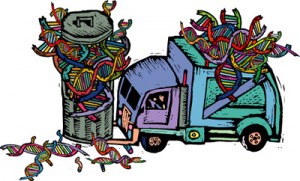 The most shocking finding of ENCODE, however, is that perhaps as much as 80% of the DNA is “biologically active.” This means that not only the regulatory regions and genes are active but also much of the other 50% of “junk” jumping gene copies are active. This critical finding means that jumping genes (“remnants”, “useless copies,” and “junk” DNA) might be producing evolutionary changes. In fact, recent information makes this seem probable.
The most shocking finding of ENCODE, however, is that perhaps as much as 80% of the DNA is “biologically active.” This means that not only the regulatory regions and genes are active but also much of the other 50% of “junk” jumping gene copies are active. This critical finding means that jumping genes (“remnants”, “useless copies,” and “junk” DNA) might be producing evolutionary changes. In fact, recent information makes this seem probable.
TEs Critical for Evolution
As we learn more about DNA in viruses, bacteria and animals, we can see that moving particles of DNA, called Transposable Elements or TEs, might be the most critical for evolution.
 When an entire sequence of DNA is copied, then entire functions can be copied and altered, rather than building up machinery and functions from the beginning with small individual mutations and small changes.This could mean that an entire arm of a protein can be copied, duplicated, or duplicated and then altered. Bacteria use this to transfer entire mechanisms of resistance to antibiotics. In bacteria this process is well known to be almost ubiquitous, and is called Horizontal Gene Transfer or HGT.
When an entire sequence of DNA is copied, then entire functions can be copied and altered, rather than building up machinery and functions from the beginning with small individual mutations and small changes.This could mean that an entire arm of a protein can be copied, duplicated, or duplicated and then altered. Bacteria use this to transfer entire mechanisms of resistance to antibiotics. In bacteria this process is well known to be almost ubiquitous, and is called Horizontal Gene Transfer or HGT.
There is now converging evidence that the movement of significant pieces of DNA in the human genome might be the most significant mechanism of evolution.
Equally important is the probability that the very important cellular epigenetic mechanisms evolved to control the random effects of these TEs.
Why “So-Called” Gene?
ENCODE showed that when RNA is transcribed from pieces of DNA, the RNA then cuts and splices these pieces together from multiple different regions that used to be called genes. How the RNA knows how to do this is not at all clear. What is significant is that the DNA pieces that contribute to the structure of a protein come from different areas, not just one area. Also, the same small pieces of DNA are used in multiple transcripts that are then translated into multiple different proteins (called alternative splicing).
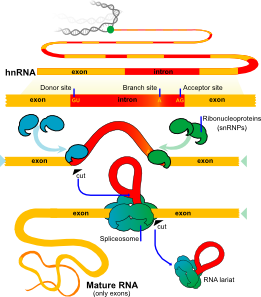 Therefore, what has been called a “gene” up until now (a piece of DNA broken into usable sections “exons” and unusable sections “introns” that need to be excised) is not really the unit that makes one protein. The splicing of the RNA makes the protein!
Therefore, what has been called a “gene” up until now (a piece of DNA broken into usable sections “exons” and unusable sections “introns” that need to be excised) is not really the unit that makes one protein. The splicing of the RNA makes the protein!
It is now thought that the real “gene” has to be the unique RNA transcript after the pieces are spliced together that will make one protein. This cutting and splicing seems to be controlled by the vast number of regulatory particles including large and small RNA (microRNA, miRNA, etc. see post for list), that regulate the entire process.
It has been known that cutting and splicing are a major part of the normal function of genes. This splicing occurs in editing mistakes in the process (see post Cellular DNA Self Editing and Error Correction) and also when the RNA splices the final transcript. So, it is not surprising that another significant process could involve splicing, and editing. Jumping genes basically use a similar mechanism of cutting and splicing to cut out pieces of DNA in human chromosomes and then paste themselves elsewhere.
This cutting and pasting is therefore, perhaps, one of the most critical mechanisms in all cellular processes: DNA error correction, splicing together the RNA transcript, and jumping genes.
Jumping Genes
For years jumping genes were basically ignored and considered “parasitic” or “junk” DNA (which is why most DNA was considered “junk”). Now, they are being viewed as, perhaps, the most important mechanism of evolution along with the epigenetic controls, such as microRNA, related to them.
There are many different types of “jumping genes”. One type cuts and pastes themselves in and out of the DNA strand (Transposons.) Another type uses an RNA to cut and paste (retro-transposons). The sum of all TEs in the human DNA makes up about 50% of the human genome. This includes:
LINEs — long terminal repeats
SINEs — short terminal repeats
Transposons,
Retrotransposons
Segmental duplications
Simple sequence repeats
 Plants appear to have the most jumping genes, with some genomes many times larger than humans with millions of self copied DNA elements. Corn has 40,000 genes, twice that of humans and 85% of their DNA is TEs. Since plants do not have as many behavioral responses as animals, it is possible they need more jumping genes to create evolutionary change in response to stress.
Plants appear to have the most jumping genes, with some genomes many times larger than humans with millions of self copied DNA elements. Corn has 40,000 genes, twice that of humans and 85% of their DNA is TEs. Since plants do not have as many behavioral responses as animals, it is possible they need more jumping genes to create evolutionary change in response to stress.
More Jumping Genes in Eukaryotes
If there are more jumping genes, the cells need to have more control over the random effects of these new genes. This increased control comes from the now well-known epigenetic mechanisms — protein repressors, histone methylation, RNA interference (RNAi), RNA directed DNA methylation as well as others (see posts on ENCODE). These processes are critical for cells to silence the effects of mistakes in DNA copying including the many copies of TEs.
 What is now known, but not widely acknowledged, is that the same ubiquitous horizontal transfer of DNA in bacteria also occurs in eukaryotes, often from microbes. In prokaryotes (bacteria) most DNA duplication is from horizontal transfer between bacteria with virus like particles. But, bacteria don’t perform as well with excess baggage. They like to minimize the amount of DNA and give up functions to others in order to travel light. Prokaryotes use the same regulatory mechanisms to control them, but jumping genes haven’t proliferated in prokaryotes.
What is now known, but not widely acknowledged, is that the same ubiquitous horizontal transfer of DNA in bacteria also occurs in eukaryotes, often from microbes. In prokaryotes (bacteria) most DNA duplication is from horizontal transfer between bacteria with virus like particles. But, bacteria don’t perform as well with excess baggage. They like to minimize the amount of DNA and give up functions to others in order to travel light. Prokaryotes use the same regulatory mechanisms to control them, but jumping genes haven’t proliferated in prokaryotes.
Eukaryotes are quite different. They tend to accumulate large amounts of extra jumping genes, both copied and altered. The largest difference between eukaryotes and prokaryotes is 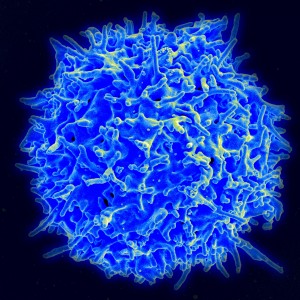 the much more elaborate epigenetic mechanisms in eukaryotes. These mechanisms, the very mechanisms elaborated in the ENCODE posts, (regulatory proteins, regulator RNA, methylation of DNA and of histones) have evolved along with the huge proliferation of DNA elements from jumping genes and viruses.
the much more elaborate epigenetic mechanisms in eukaryotes. These mechanisms, the very mechanisms elaborated in the ENCODE posts, (regulatory proteins, regulator RNA, methylation of DNA and of histones) have evolved along with the huge proliferation of DNA elements from jumping genes and viruses.
The enzymes and epigenetic particles that allow jumping genes to move and make copies in addition to their being silenced have been available for many years in eukaryote cells, but only relatively recently in advanced animals have the jumping genes proliferated extensively.
Two Opposing Forces of Change – Copies and Control
These two opposing forces appear to be related, that is, the huge proliferation of new DNA particles with the cell’s multiple epigenetic mechanisms to control them.
 This is similar to the constant and vast war between viruses and bacteria in nature (see post on Viruses). These two intelligences, bacterial and virus, have very intense interactions determining the survival and evolution of the species. Individual bacteria seem to show the most intelligence (see posts on Microbe Communication). If viruses also show intelligence (which they must to stay in the battle with bacteria) then what about virus like particles in bacteria and other cells? What about jumping genes?
This is similar to the constant and vast war between viruses and bacteria in nature (see post on Viruses). These two intelligences, bacterial and virus, have very intense interactions determining the survival and evolution of the species. Individual bacteria seem to show the most intelligence (see posts on Microbe Communication). If viruses also show intelligence (which they must to stay in the battle with bacteria) then what about virus like particles in bacteria and other cells? What about jumping genes?
In the same way, jumping genes must show the same intelligence.
There are many important cellular functions that use the same basic splicing and copying DNA and epigenetic control.
The human immune system uses enzymes to re-combine pieces of DNA to make the almost infinite variety in antibodies, which evolved from these same systems used by TEs to generate sequence.
Transposons are involved with centromeres and imprinting which creates different expression from males and female gametes.
Transposases, the enzymes the cut the TEs and attach them to new sequences, are some of the most common enzymes in nature.
When heat shock, other environmental stress, or infection from predatory microbes, the genome responds with the activation of the TE processes. This is true in yeast, flies and human cells. It is now shown that these stresses increase the capacity to withstand this stress, which can be inherited through epigenetic mechanisms. When the stress subsides then these increased amount of jumping genes also subsides.
Epigenetic mechanisms are not only critical for the entire transcription process and structure, but they stimulate more jumping genes. These epigenetic processes slow the effects of these multiple jumping genes to a gradual effect. Epigenetic processes can allow for dramatic restructuring and self-engineering of eukaryote cells.
Jumping genes are also being shown to be important in a variety of important diseases such as ALS, degenerative neurological disorders, and cancer
Interrelated Epigenetic mechanisms and Jumping Genes
Increasingly, these two processes, that is, TE’s and the elaborate epigenetic mechanisms, have evolved together in animal and plant lines. There is a question now as to whether epigenetics is primarily concerned with controlling the vast amount of jumping genes, more than half of the DNA in humans.
One reason why regulation with RNAs evolved with jumping genes is that they are not limited to a specific region on the chromosome. The RNA interference mechanisms can control the effect of the jumping gene wherever it is.
Are these the actual mechanisms of evolution? This new view is that epigenetic mechanisms along with massive TE’s are exactly the evolutionary mechanism.
Viruses and Virus Particles in Bacteria Are Jumping Genes
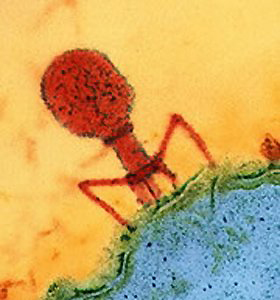 A previous post discussed the remarkable capabilities of viruses to elude the defenses of human and bacterial cells. It is well known that viruses transfer a significant amount of DNA into bacteria. It has also become apparent that retroviruses also inject a significant amount of DNA into the human genomes.
A previous post discussed the remarkable capabilities of viruses to elude the defenses of human and bacterial cells. It is well known that viruses transfer a significant amount of DNA into bacteria. It has also become apparent that retroviruses also inject a significant amount of DNA into the human genomes.

Remarkably, bacteria seem to create virus like particles, a piece of DNA or RNA and a protein, with a mechanism to transfer them. One very dramatic mechanism is called the secretion IV systems, and appears like a syringe, almost identical to the phage virus, in order to inject DNA into another cell. With this mechanism, after packing and stuffing the syringe, they can shoot a piece of DNA to another cell.
Some bacteria, under threatening condition, can create their own phage viruses with the purpose of killing another microbe. One study showed that E. Faecalis makes many phage viruses to kill off other competitors.
Bacterial Intelligence and Virus Intelligence
Multiple posts have shown that microbes demonstrate decision making, group communication, even altruism, and have a primitive form of consciousness. A post on viruses shows that viruses also show primitive cognitive processes. Symbiosis has been seen to be ubiquitous in microbes and now with microbes and higher order cells, in 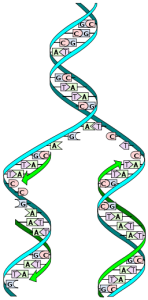 eukaryotes basic structure. It is not unreasonable to suppose that this symbiosis occurs also with viruses, viroids, and bacteria.
eukaryotes basic structure. It is not unreasonable to suppose that this symbiosis occurs also with viruses, viroids, and bacteria.
But, what are viruses? They are strands of RNA or DNA with protein coatings.
What are jumping genes? They are pieces of DNA with the same associated protein enzymes that are needed to copy themselves and move.
Jumping genes in our chromosomes are in fact, similar to viruses. They are a strand of DNA with associated proteins and enzymes to move and copy themselves just as viruses are. If viruses have a form of cognition, then what about pieces of DNA in our genome that are the major driving forces of evolution?
Jumping Gene Intelligence – Cellular Self Editing
In bacteria, the secretion of communication signals is not random. They achieve very specific aims. Are their horizontal gene transfers of TEs also not random but used to achieve evolutionary purposes, such as antibiotic resistance? Do viruses also have a purpose in their rapid and constant transfer of DNA?
 These same questions need to be asked about jumping genes. If jumping genes are like viruses and if they are used in cellular self editing processes like the cellular DNA error corrections, and the vital RNA splicing, then do jumping genes also have primitive forms of cognition?
These same questions need to be asked about jumping genes. If jumping genes are like viruses and if they are used in cellular self editing processes like the cellular DNA error corrections, and the vital RNA splicing, then do jumping genes also have primitive forms of cognition?